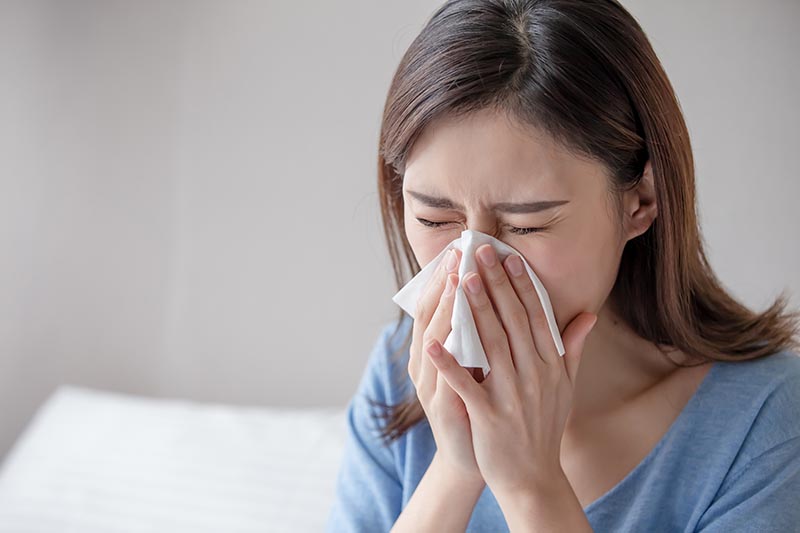Dogs are a massive part of many people’s lives, and it’s no surprise that they are one of the most popular pets in the world. Approximately 44.5% of all households in the United States own a dog, while only 29% own a cat.1
However, there are many misconceptions about canines out there! This article goes over the most common myths to help clear up a few things.
The 15 Dog Myths & Misconceptions
1. Aggression Is Based on Breed
Many people consider some breeds to be more “dangerous” than others. There are whole laws focused on banning certain dangerous breeds. Pit Bulls often fall into this category. They’re one of the most common breeds considered “dangerous” (though what exactly counts as a Pit Bull isn’t even that clear). German Shepherds, Jack Russell Terriers, Collies, Chow Chows, and other breeds are commonly considered aggressive too.
However, the American Veterinary Medical Association performed a peer-reviewed summary of current dog aggression studies. It found that the breed of a canine isn’t linked to aggression or bite risk. Banning certain breeds doesn’t seem to lower overall dog bites either. Dog bites from that specific breed will go down simply because they are no longer allowed in the area. However, dog bites overall do not decrease.
Many other factors determine whether a dog is aggressive. For instance, the dog’s training and socialization are among the most critical factors involved. Any unsocialized canine is more likely to bite than a socialized dog, no matter their breed.

2. Grain-Free Diets Are Healthier
Many dog owners mistakenly believe that grain-free food is automatically better than grain-inclusive foods. However, this is not necessarily the case, despite what many of the “premium” dog food companies would lead you to believe.
Dogs are not wolves. They have different dietary requirements. Dogs have coexisted with humans for thousands of years, and they have evolved to consume grains over the last thousands of years because they have been eating grains from human settlements for that long. Those that could digest grains more efficiently likely had the upper hand, passing the trait on to the next generations.
Furthermore, grain-free diets have been linked to certain heart conditions by the FDA. Canine dilated cardiomyopathy was linked to grain-free diets high in peas, lentils, legumes, and potatoes. The exact link isn’t clearly understood yet. However, it seems likely to have something to do with the lack of grain (or over-inclusion of peas and similar veggies) in a dog’s diet.
Grain allergies are also infrequent in dogs. Gluten sensitivities only happen in a select few breeds. Most dog food allergies are linked with animal proteins, especially chicken and beef. Therefore, there are a few reasons that you should be feeding your dog grain-inclusive food.
3. Wagging Tails Are Always Happy
“But their tails are wagging!” is a common phrase among pet owners. Even if the dog is acting aggressively otherwise, tail-wagging is often considered a sign of happiness. So, if a dog’s tail is wagging, they must not be upset.
However, this is not true in the least. Tail-wagging is not always a sign of happiness. It can also be a sign that your dog is feeling threatened, stressed, or anxious. If your dog is in a confrontation with another dog, tail-wagging is likely not a sign that your canine is having a good time.
If you notice other potentially harmful behaviors, don’t let tail-wagging be an excuse not to step in and do something about it. While you’re at it, consider getting a book or two on dog body language to learn how to correctly interpret all your dog’s signals.

4. One Dog Year Is Seven Human Years
There is a common misconception that 1 dog year is equal to 7 human years. However, this is not true. Different breeds have different lifespans, which means that they age differently too.
Dogs don’t age at the same rate as people. For instance, big dogs often hit sexual maturity later, but they also live for a shorter period. Their lifespan is not congruent with people in the least.
This theory likely came about by someone taking the average dog lifespan, comparing it to human years, and determining that humans live about seven times longer than dogs. However, a dog’s lifespan can vary so widely that while this theory may work for some dogs, it’s inaccurate for the most part.
Your best bet is to look at your dog’s growth cycle, not compare their lifespan artificially to those of people. This theory can be particularly unhelpful when dogs are young. Puppies don’t develop at the same rate as children, including the ages that they hit sexual maturity.
If you want to learn more about dog development, we recommend purchasing an accurate book about puppies instead of relying on this old theory.
5. Dog Breeding Is Easy
Many people mistakenly believe that breeding dogs is as easy as putting a male and a female together. But we do not recommend breeding your dog unless you are a professional breeder. There is much more that goes into breeding dogs than most people realize. You’ll need to do genetic testing and regular health exams on your breeding dog(s), give them high-quality food, and find suitable homes for all the puppies. You’ll also need to research your dog’s pedigree, find a dog that’s suitable for yours, and then pay for the breeding.
If you’re going to do it correctly, it will likely cost thousands of dollars. It also isn’t something that you do in your free time. Furthermore, just because you bought your dog from a professional breeder for $1,000 doesn’t mean you’ll be able to sell your dog’s puppies for that much. You aren’t a professional and therefore, will likely need to sell your dogs for much less. You’ll also need to check if you are even able to breed your dog based on the contract with the breeder you purchased them from.
You should plan on losing money on your dog’s litter, given the costs required to carry out successful breeding and produce healthy puppies.

6. Dogs Have Clean Mouths
Dogs naturally have bacteria in their mouth that help them stay healthy, so there is a myth that their mouths are cleaner than ours. However, the dog’s mouth is full of bacteria that aren’t necessarily good for you. Therefore, dogs can quickly get you sick by licking your face or open wounds.
Your dog cannot magically heal your wounds with their tongue—or even their wounds, for that matter. This is a common misconception that can potentially lead to infections and illness. There is a reason that dogs aren’t supposed to lick their incision after having surgery. It can irritate it, generate heat and moisture, and introduce bacteria.
7. Rescue Dogs Have Problems
Most rescue dogs aren’t taken to animal shelters because they have severe behavioral issues. It’s usually because their previous owners finally realized what they had gotten themselves into.
Puppies are cute and cuddly but they can grow into big dogs. Many canines also go through a “teen” period around sexual maturity, when they suddenly seem to take a few steps back behavior-wise. However, this is just a reminder to continue investing time in training your dog, always using positive reinforcement-based methods.
People also turn dogs over to shelters due to changes in their financial situation or lifestyle. You might be surprised by the number of dogs that are given away simply because their owners are moving or having a new baby. Actual behavioral problems are rarely the reason for turning over a dog.
Therefore, when you adopt a rescue dog, you likely aren’t going to end up with a dog with problems. In fact, a rescue dog is just as likely to have underlying behavioral problems as a puppy that you adopt. It’s all about how you raise, train, and socialize them from the moment you bring them home.

8. A Fenced-In Yard Is All a Dog Needs
Many people may put their dog in a fenced-in yard and assume that they’re getting all the exercise that they need. However, this isn’t true in the slightest. Many dogs will not exercise when placed in a backyard by themselves. They’d much rather spend their time lying around than exercising—unless something fun is going on! (They’re a bit like humans in this regard.)
Even if you have a fenced-in yard, you still need to take your dog on regular walks. Playtime in the backyard can be a great way to exercise your canine, but only if they’re actually expending a decent amount of energy. A dog trotting around the backyard is not exercising, for example, but a dog playing fetch is.
Feel free to spend time playing in your backyard as part of your dog’s exercise requirements. However, don’t rely on them to exercise themselves.
9. Some Breeds Are Hypoallergenic
There is no such thing as a hypoallergenic dog. No specific breed produces fewer allergens than another. The concept of a hypoallergenic dog is a myth itself. Certain proteins that all dogs produce are what cause canine allergies. One individual dog may produce fewer allergens than another; however, all dogs produce allergens, which are carried by hair and dander. Until they come up with a skinless, saliva-less, urine-less canine, no dog will be free from allergens (and that would be terrifying!).
Studies have found that different breeds produce similar allergen loads and that there’s no difference between breeds that are considered hypoallergenic and breeds that aren’t. They’re the same in terms of allergens produced and the reactions that they bring about in allergic humans.
That said, there is a bit of truth to this idea—just not regarding breeds.
Different types of canine allergens exist, and not everyone is allergic to all the proteins. In most cases, those with dog allergies are just allergic to one or two proteins. The most common protein is Can f 1. Sadly, all dog breeds make high levels of this allergen, so there isn’t much that you can do if you’re allergic to Can f 1.
However, other proteins are only produced in certain situations. For instance, there is one protein called Can f 5 that only intact male dogs produce. If you’re allergic to this specific protein, you can be around female dogs without any issues, as they don’t make the protein that bothers you!
Allergy tests often check for all dog proteins at the same time. However, specific protein tests are available at your doctor’s office; you just have to ask!
Ultimately, though, don’t fall for the misconception that a hypoallergenic breed will prevent you from suffering allergy symptoms. That’s simply not the case.

10. It’s Harder to Train Older Dogs
A common myth about dogs is that there is a significant trainability difference between older dogs and younger dogs. But there is no reason that you can’t train an older dog, even if they haven’t had much training as a puppy. In fact, older dogs are sometimes easier to train because they have a longer attention span. Puppies tend to get distracted!
We highly recommend continuing with training as your dog gets older. It provides excellent mental stimulation, which can help your dog age gracefully and engage in fewer destructive behaviors. Also, one-on-one bonding time is beneficial for all dogs.
If you continuously train your dog from a puppy to an adult, you’re likely going to run out of tricks eventually. So, we recommend training your dog in more challenging situations with more distractions. It’s an easy way to raise the difficulty without actually introducing new tricks.
11. Puppies Need Extra Food
Some misinformed puppy owners believe that feeding puppies more will make them grow bigger. However, this is not the case. Feeding a puppy more may affect their rate of growth. They may become overweight or even obese as a puppy, for instance. But it won’t affect their growth when they reach adulthood. They’ll still be whatever size they were originally going to be. In fact, too much food may mean they are overweight when they hit adulthood.
Furthermore, overfeeding your puppy can result in all sorts of health problems when they get older. Overfeeding large and giant breed puppies is associated with a higher risk of developmental orthopedic diseases, such as osteochondrosis and osteochondritis dissecans.
You should always follow a vet’s and the food manufacturer’s feeding recommendations for your puppy. Many puppies may seem a bit on the skinnier side, as dogs tend to grow in height before they grow in weight. You can expect your dog to bulk up a bit after they hit adulthood.

12. Some Breeds Are Just Friendly
A few breeds out there are known for their friendliness, to the point that people consider them to be innately friendly. However, this isn’t always the case.
Some breeds have fewer territorial instincts than others, which often makes them less aggressive and more trusting of strangers. But that doesn’t mean that this breed will be innately friendly; they still require socialization.
Any dog breed can potentially become aggressive if they are not socialized properly. Don’t get a breed like a Golden Retriever under the misconception that they’ll be naturally friendly without significant socialization. You will still need to take your puppy out and about to get them used to people!
13. It’s Easy to Tell When a Dog Is Sick
It is not uncommon for dog owners to ignore what they believe are relatively mild clinical signs. After all, if a dog isn’t acting sick, they can’t be feeling “that bad.”
However, depending on their personality, some dogs will show only subtle signs of illness and may, despite feeling unwell, still be willing to eat or play if encouraged. If your dog begins to act sickly, they have likely been ill for a while, so it is time to seek veterinary help. Sometimes, dogs don’t show any severe signs until it is too late for an effective treatment. When dogs begin acting lethargic and refuse to eat, it is often past the time for a straightforward cure.
We highly recommend taking your dog to the vet at the first sign of trouble. They are good at masking their clinical signs and can quickly head downhill once they begin acting sickly.
Did you know you can speak to a veterinarian without having to travel? Just head over to PangoVet. It's our online service where you can talk to a vet online and get the advice you need for your pet — all at an affordable price!

14. Small Dogs Are Better With Children
Kids are small, so small dogs must be the best option for them. However, this is simply not true. Any dog, regardless of their size, that has not been properly trained and socialized is not recommended to be around children.
Conversely, toy dogs are more likely to be harmed by small kids. A child can easily hurt a Chihuahua if they accidentally lie on them or if they fall when trying to pick them up, for example. A hurt dog is likely to lash out and bite the child. After all, they want the kid to stop hurting them! Most dog bites of children fall into this category. Fortunately, these aren’t usually severe; they’re more like “warning bites” to make the kid stop hurting them.
Additionally, some small dogs are more likely to be scared of small children. This may be because a kid previously injured them, or the dog knows that the child may injure them. Many small dogs are quite untrusting of small kids for this reason. They may hide or snap at a young child, for instance.
Ultimately, all interactions between dogs and kids should be supervised by adults.
15. Dogs Shouldn’t Growl
Many people correct dogs when they growl. However, generally speaking, we don’t recommend this. Growling is a dog’s means of communication to let you know that something is not right. The growling could stop, but the dog’s anxiety about the situation would remain.
It is better to have a dog that warns you about not liking something than jumping straight to biting. Growling is a warning that most people understand, even children. It stops them in their tracks and makes them rethink what they’re doing. It is a communication tool, even if it is a negative one.
 Conclusion
Conclusion
There are many misconceptions about dogs out there. Knowledge is essential for responsible dog ownership, so we recommend educating yourself as much as possible, starting with debunking these common myths.
Be sure to look for the scientific basis behind a “fact” before believing it. Many misconceptions are circulating out there today. Fortunately, proper research has never been more accessible, thanks to the internet.
Related Read:
Featured Image Credit: BIGANDT.COM, Shutterstock



















